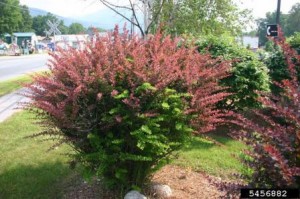Japanese barberry is multi-branched dense shrub that can grow to 2.5 m (8 ft) in height. Shiny green to burgundy leaves are alternate along its thorny stems. Solitary yellow flowers bloom from March to April, and the fruit is a round or elliptical red berry. Japanese barberry is a popular landscape shrub that has escaped into many natural areas, and can grow in dense thickets in the understory of woods and forests. It is a prolific seed producer, and numerous birds eat and subsequently disperse the seeds.
A. Pulling by hand or weed wrench
A.Pulling by hand or weed wrench:
Hand pulling can effectively control small populations of Japanese barberry, since it can be done during most of the year and plants pull up easily in most forested habitats. To avoid injury from the sharp spines, heavy gloves and long-sleeved shirt are recommended. Barberry breaks bud early in the spring, thus it is easy to see in springtime before other deciduous plants leaf out. If plants have fruit present, they should be bagged and disposed of to prevent seed dispersal. Care should be taken to minimize soil disturbance. If lacking berries, uprooted shrubs can be piled and left as cover for small animals. For larger shrubs, a weed wrench provides the necessary leverage to pull up the plant by its roots and also minimizes contact with the thorny stems.
B.Mowing/Cutting:
Repeated mowing or cutting will control the spread of Japanese barberry but will not eradicate it. Stems should be cut at least once per growing season as close to ground level as possible. Hand cutting of established clumps is difficult and time consuming due to the prolific thorns.
C.Herbicides:
Japanese barberry breaks bud earlier in the spring than most woody species. Thus, it is possible to selectively spray its young leaves before other woody species have produced leaves. For such early season treatments, triclopyr is usually more effective than glyphosate. Wait until significant leaf expansion to ensure sufficient absorption of triclopyr. From mid summer to fall, both glyphosate and triclopyr are effective when applied as foliar sprays or as cut stump treatments.
ROUNDUP [glyphosate (41%)]:
Foliar spray: 2 fl. oz./gal
Cut-stump treatment: Diluted with equal part water (1:1)
BRUSH-B-GON [triclopyr (8%)]:
Foliar spray: 4 fl. oz./gal
Cut-stump treatment: Undiluted
